目录
一、ansible——自动化运维工具
1.1 Ansible 自动运维工具特点
- Ansible 与 Saltstack 均是基于 Python 语言开发,Ansible 只需要在一台普通的服务器上运行即可,不需要在客户端服务器上安装客户端。因为 Ansible 是基于 SSH 远程管理,而Linux服务器大都离不开SSH,所以Ansible不需要为配置工作添加额外的支持。
- Ansible 安装使用非常简单,而且基于上千个插件和模块实现各种软件、平台、版本的管理,支持虚拟容器多层级的部署。很多读者在使用 Ansible 工具时,认为 Ansible比 Saltstatck 执行效率慢,其实不是软件本身慢,是由于 SSH 服务慢,可以优化 SSH 连接速度及使用 Ansible 加速模块,满足企业上万台服务器的维护和管理。
1.2 Ansible 运维工具原理
- Ansible分为控制端和被控端,主要是基于SSH协议去管理客户端,被控端是无需安装Agent插件的,Ansible会读取控制端hosts文件,根据文件中定义IP列表信息,调取本地的各个模块对被控端机器实现批量、并发的配置管理和维护,如果任务比较复杂可以写成PlayBook剧本进行分发管理;
Ansible 自动运维管理工具优点:
- 轻量级,更新时,只需要在操作机上进行一次更新即可;
- 采用 SSH 协议;
- 不需要去客户端安装 agent;
- 批量任务执行可以写成脚本,而且不用分发到远程就可以执行;
- 使用 python 编写的,维护更简单;
- 支持 sudo 普通用户命令;
- 去中心化管理。
二、安装ansible
#192.168.19.2
hostname ansible
su
#192.168.19.3
hostname webserver
su
#192.168.19.4
hostname mysql
su
systemctl stop firewalld
setenforce 0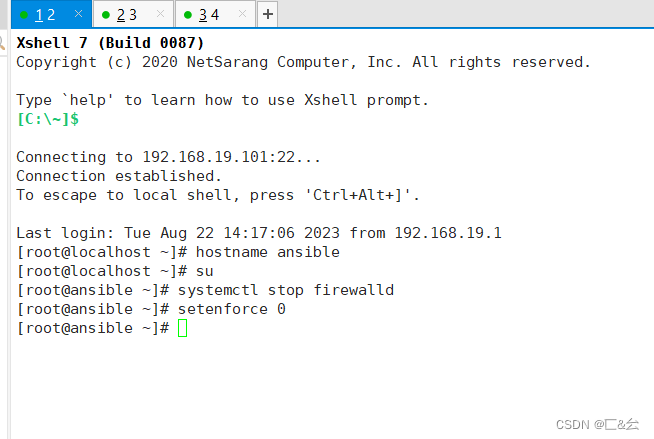

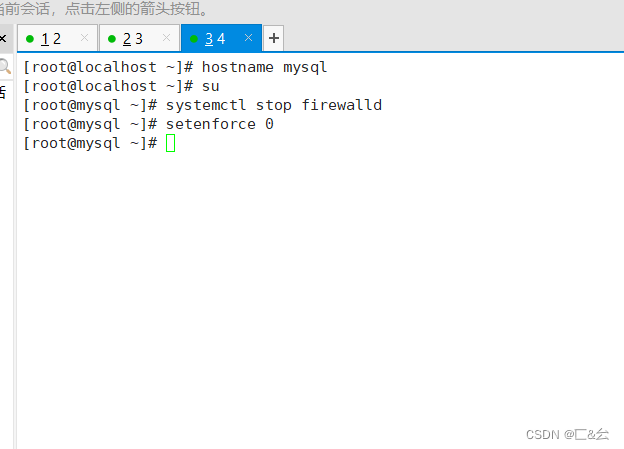
#安装epel扩展源
yum -y install epel-release
yum -y install ansible 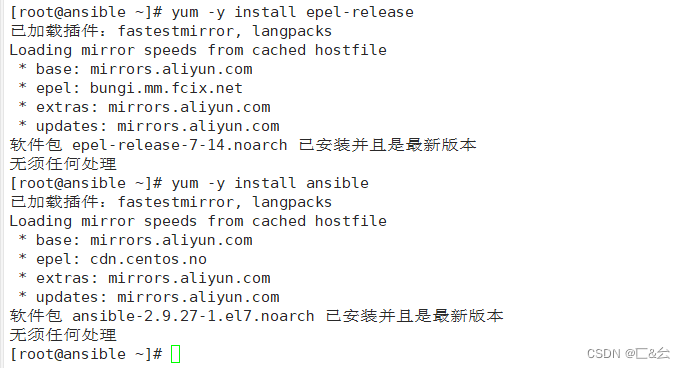
#树型查询工具
yum -y install tree
tree /etc/ansible 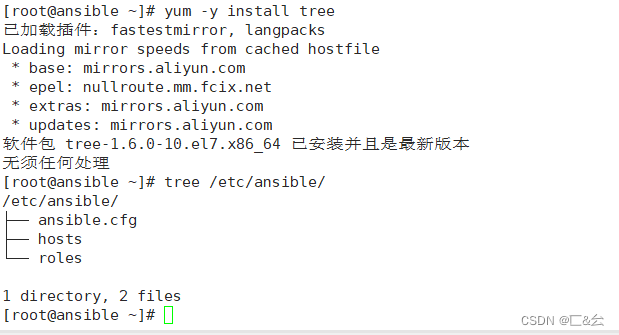
vim /etc/ansible/hosts
#配置主机清单
[webservers]
192.168.19.3
[dbservers]
192.168.19.4 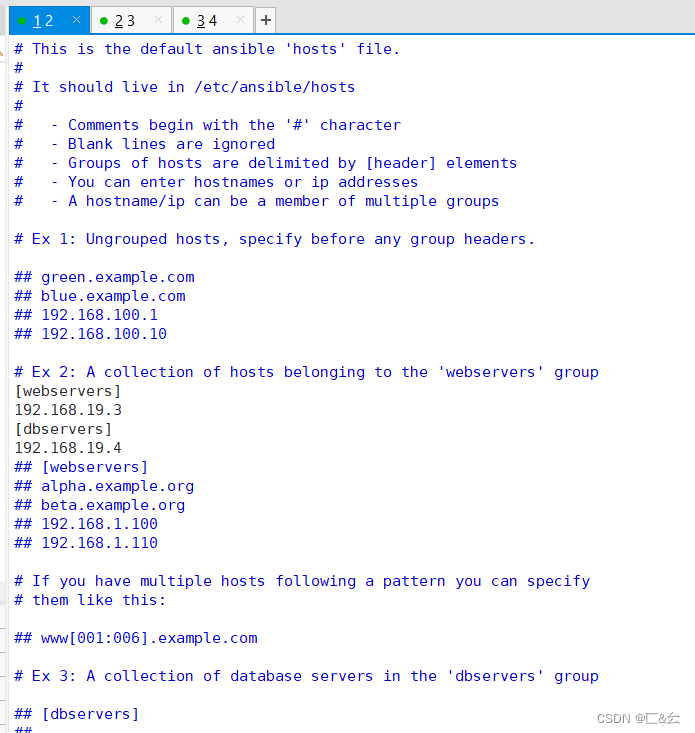
#生成密钥对
ssh-keygen -t rsa
123123
123123
ssh-copy-id root@192.168.19.3
ssh-copy-id root@192.168.19.4 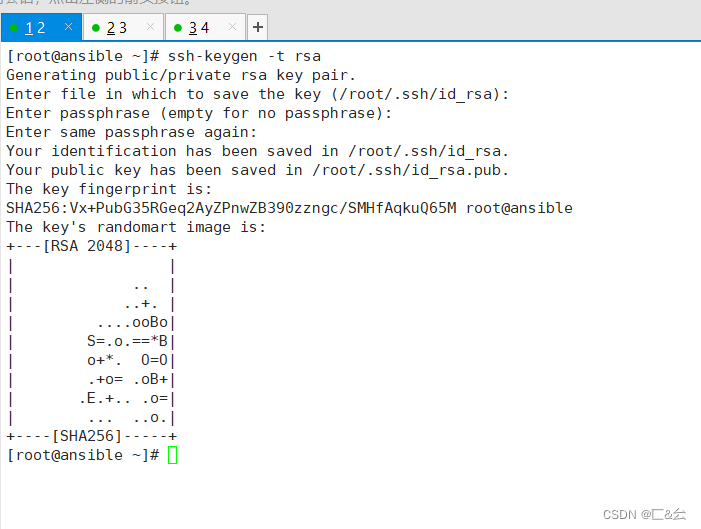

每次查询都需要输入密钥
#可以使用ssh-agent代理
ssh-agent bash
ssh-add
123123
ansible webserver -m command -a 'date' 

三、ansible命令模块
3.1 command模块
命令格式:ansible [主机] [-m 模块] [-a args]
#列出所有已安装的模块,按q退出
ansible-doc -l
#所有主机执行data命令,其中all可以换成IP或者分类名称,例:192.168.19.2 / webserver
ansible all -m command -a 'date'
#不加-m模块,则默认使用command模块
ansible all -a 'date'
ansible all -a 'ls /'
//常用的参数:
chdir:在远程主机上运行命令前提前进入目录
creates:判断指定文件是否存在,如果存在,不执行后面的操作
removes:判断指定文件是否存在,如果存在,执行后面的操作
ansible all -m command -a "chdir=/home ls ./"
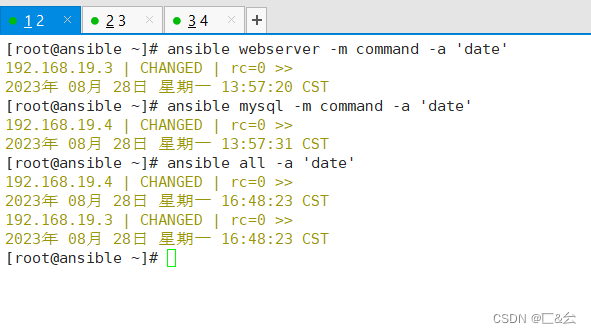


3.2 shell模块
//在远程主机执行命令,相当于调用远程主机的shell进程,然后在该shell下打开一个子shell运行命令(支持管道符号等功能)
ansible-doc -s shell
ansible dbservers -m shell -a 'echo 123456 | passwd --stdin test'
ansible dbservers -m shell -a 'echo $(ifconfig ens33 | awk "NR==2 {print $2}") | cut -d " " -f2'
ansible dbservers -m shell -a 'echo $(ifconfig ens33 | awk "NR==2 {print \$2}")'
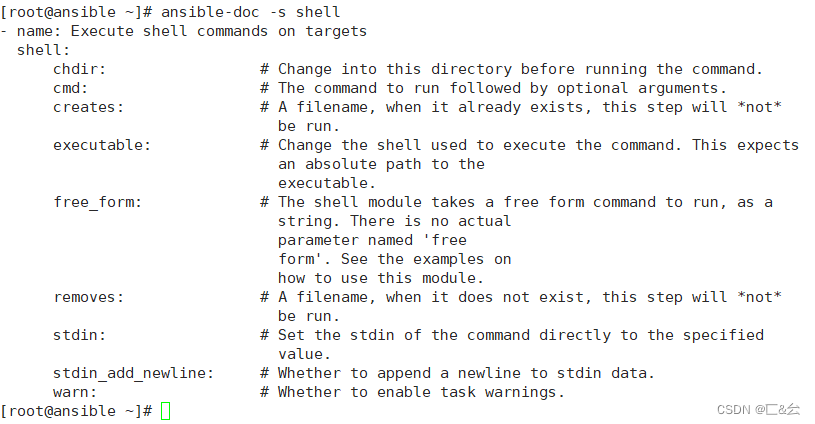

3.3 cron模块
//在远程主机定义任务计划。其中有两种状态(state):present表示添加(可以省略),absent表示移除。
ansible-doc -s cron #按 q 退出
//常用的参数:
minute/hour/day/month/weekday:分/时/日/月/周
job:任务计划要执行的命令
name:任务计划的名称
ansible webservers -m cron -a 'minute="*/1" job="/bin/echo helloworld" name="test crontab"'
ansible webservers -a 'crontab -l'
ansible webservers -m cron -a 'name="test crontab" state=absent' #移除计划任务,假如该计划任务没有取名字,name=None即可
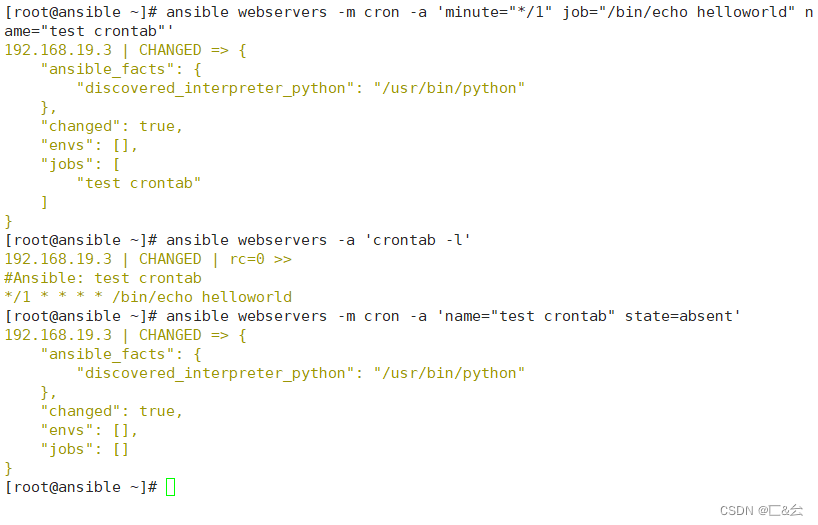
3.4 user模块
user模块是请求三条指令,useradd,userdel,usermod
#模块信息
ansible-doc -s user
#创建用户
ansible all -m user -a 'name=yh'
#查看用户账户信息
ansible all -m 'command' -a 'tail -1 /etc/passwd'
#移除指令
ansible all -m user -a 'name="yh" state=absent'

3.5 group 模块
//用户组管理的模块
ansible-doc -s group
ansible dbservers -m group -a 'name=mysql gid=306 system=yes' #创建mysql组
ansible dbservers -a 'tail /etc/group'
ansible dbservers -m user -a 'name=test01 uid=306 system=yes group=mysql' #将test01用户添加到mysql组中
ansible dbservers -a 'tail /etc/passwd'
ansible dbservers -a 'id test01' 
3.6 copy模块
对文件进行有效的复制
ansible-doc -s copy
ansible dbservers -m copy -a 'src=/etc/fstab dest=/opt/fstab.back'
ansible dbservers -a 'ls /opt'
ansible dbservers -a 'cat /opt/fstab.back'
ansible dbservers -m copy -a 'content="hello lic" dest=/opt/test.txt'
ansible dbservers -a 'cat /opt/test.txt'

3.7 file模块
ansible-doc -s file
ansible dbservers -m user -a 'name=mysql system=yes'
ansible dbservers -m file -a 'owner=mysql group=mysql mode=600 path=/opt/test.txt'
ansible dbservers -a 'ls -l /opt/test.txt'
#创建
#ansible dbservers -m file -a 'path=/opt/abc.txt state=touch'
ansibledbservers -m file -a 'src=/opt/test.txt path=/opt/test.txt.link state=link'
ansible dbservers -a 'ls -l /opt'
#移除文件/opt/test.txt
ansible dbservers -m file -a 'path=/opt/test.txt state=absent' 
3.8 ping模块
ansible all -m ping 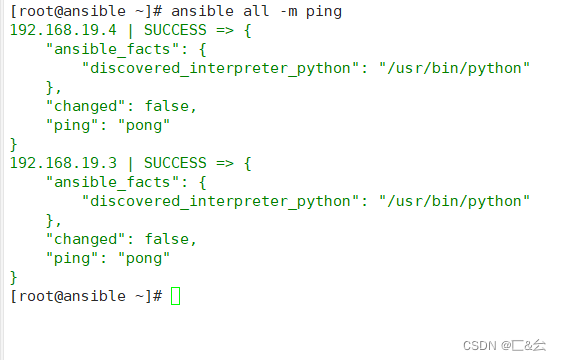
3.9 service模块
ansible-doc -s service
#192.168.19.3执行
yum -y install httpd

ansible webserver -a 'systemctl status httpd'
ansible webserver -m service -a 'enabled=true name=httpd state=started'
systemctl status httpd
systemctl is-enabled httpd 
3.10 script模块
ansible-doc -s script
vim test.sh
#!/bin/bash
echo 'hello ansible from script' > /opt/script.txt
chmod +x test.sh
ansible all -m script -a 'test.sh'

3.11 yum模块
ansible-doc -s yum
ansible dbservers -m yum -a 'name=httpd'
ansible dbservers -a 'rpm -q httpd'
ansible dbservers -m yum -a 'name=httpd state=absent'
ansible dbservers -a 'rpm -q httpd'

3.12 setup模块
ansible-doc -s setup
#获取MySQL组主机的facts信息
ansible dbservers -m setup





















 被折叠的 条评论
为什么被折叠?
被折叠的 条评论
为什么被折叠?








